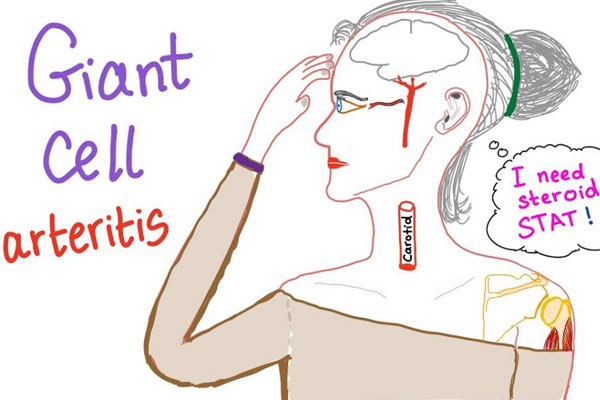
A typical rheumatologist in the UK actually treats more than just arthritis. I treat a variety of rheumatological and autoimmune conditions, including many you have probably never heard of. Giant cell arteritis (GCA) is a good example.
GCA is a form of vasculitis sometimes referred to as temporal arteritis. The ‘temporal’ designation comes from the fact that one of the primary symptoms of the disease is inflammation of the blood vessels in the temporal region of the head.
Regardless of the name a doctor chooses to use, GCA is a serious condition that requires immediate treatment. If not treated, it can lead to serious consequences – including stroke and blindness.
Primary Symptoms of the Disease
GCA symptoms present differently depending on which arteries are affected. The most frequently observed symptoms are:
- pain and tenderness in the temples
- frequent headaches (often severe)
- jaw pain when talking or eating
- loss of vision in one or both eyes
- double vision
- flu-like symptoms (fatigue, weight loss, etc.).
In some cases, the symptoms are accompanied by visible inflammation. In other words, you can actually see the inflamed blood vessels underneath the skin. However, note that visible blood vessels alone are not enough to diagnose the disease.
How GCA Is Diagnosed
GCA is one of the most common forms of vasculitis in the UK. It is primarily observed in older patients over the age of 50. GCA is similar to other forms of vasculitis in the sense that a GP or rheumatologist cannot run a single test to find it.
A diagnosis usually begins with the observation of numerous symptoms and clinical signs. If a doctor suspects GCA, he or she can order blood tests that will show whether or not general inflammation is present. A positive blood test might lead the doctor to order a biopsy of the temporal arteries. As an alternative, ultrasound scans can sometimes provide the same information as a biopsy.
How GCA Is Treated
Since GCA can lead to things like vision loss and stroke, there are two goals for treatment. The first goal is to reduce inflammation so as to increase blood supply. The more inflammation can be brought under control, the lower the risk of serious complications. The second goal of treatment is to alleviate the symptoms.
We normally start with high dosage steroids to bring down inflammation. That lasts for a few weeks. We follow up with a reducing regime of steroids to keep things under control. This secondary part of treatment can go for as long as a couple of years. It really depends on how the patient responds.
If steroids are not enough, we can supplement with other treatments. Low-dose aspirin can reduce the risks of heart attack and stroke. Immunosuppressants can help to prevent inflammation from returning. Doctors sometimes turn to proton pump inhibitors and bisphosphonate therapy to counteract some of the unintended side effects of steroid treatment.
If you believe you are exhibiting the symptoms of GCA, please do not wait to be seen by a doctor. Contact your GP or reach out to my London office urgently. As a rheumatologist offering private health consultations, I am well-versed in the symptoms of GCA. We can work together to figure out what is going on and get you on the right course of treatment.
What to do if you suspect you have Giant cell arteritis (GCA)
Although giant cell arteritis, or GCA, is a condition where arteries in the head and neck become inflamed, most people suffering a sudden increase in headaches or neck and jaw pains wouldn’t automatically suspect that they have GCA.
Some of the common symptoms of GCA can include flu-like symptoms. Many people may believe they have a virus and will often treat themselves with over the counter cold and flu medications only to find their symptoms don’t resolve.
As GCA is more common in the over-50 age group, many people attribute their symptoms to the ageing process. However, it would be best if you didn’t ignore the symptoms of this condition because you could be putting your eyesight at risk.
Don’t put your eyesight at risk
One of the arteries commonly affected by GCA is the one delivering blood to the optic nerve. Should this artery become affected, it will starve the optic nerve of blood and cause irreversible loss of sight.
It is scary that around 3000 people each year lose some or all of their sight due to giant cell arteritis. You are also more at risk of developing GCA if diagnosed with polymyalgia rheumatica, or PMR.
The problem with GCA is that the condition can develop suddenly and become dangerous very quickly. This is why you should get any of the symptoms of GCA checked out by your GP or directly with Dr Bhadauria as soon as possible.
There is every chance that your symptoms may be caused by something less problematic, but it can be a great relief to have this severe condition ruled out. However, when caught early enough, GCA can be treated, and your sight can be saved.
Article by Dr. Naveen Bhadauria



